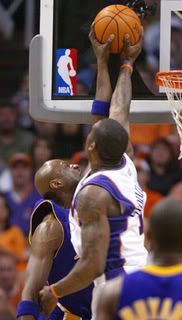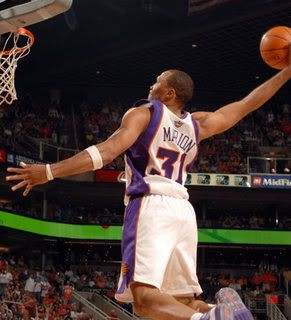- Although the Suns lost the offensive rebounding battle for the game 19-6, they actually won it in the second half 6-4. Overall, the Suns out-rebounded the Lakers 21-19 in the second half.
- The Suns had 14 fewer free throw attempts for the game, but only got 5 fewer attempts in the second half.
- Both teams had the same amount of fouls in the second half with 8 each.
- The turnovers were even at 8 in the first half. The second half was a different story, though, as Phoenix had 8 and LA had only 4.
I'm not sure what to make of all that quite yet. I'm still mulling over other stats, which is keeping me up late into the night. (No, I do not have a life.) For instance, the Suns gave up 17 points off their 16 turnovers, but only capitalized on the Lakers 12 turnovers for a measly 8 points. LA dominated in the paint, scoring 52 points to the Suns' 30 for the game. I don't have half time stats for those...sorry. It makes it even harder to process all the new information, so the chances of anything coming of it are on a quantum scale at best.
One thing that does disturb me is the timeliness of the foul calls and who got them. Amare had 4 fouls called on him for the game, while Kwame had only 1. How does a starting center get away with a 2 block, 1 foul game? And similarly, how does Lamar Odom get 8 rebounds and 2 fouls in the first half, then get 8 more rebounds and zero fouls in the second half? Amare had 10 rebounds for the game (3 in the first - two fouls, 7 in the second - two fouls). Kwame Brown had 4 offensive rebounds in the first half when he picked up his lone foul, followed by 2 defensive rebounds and both blocks with no fouls in the second.
And how does Kobe Bryant's 7 of 9 two-point shooting in the first half translate into 3 fouls, then suddenly balloon to 6 of 14 two-point shooting and 10 foul shots in the second half? Obviously the Suns did a better job defensively on him in the second half because he made one fewer shot in one-and-a-half times the attempts. Yes, he was more aggressive in the second half, but does that not scream of a huge bail-out? (I'll remind you that one of the fouls he drew came on a late whistle that blew as the ball hit the floor, and that shot was about 12 feet away from the basket.)
Moreover, with all the aggressive trapping the Lakers did, shouldn't there have been a few more whistles in the Suns' favor...enough to put LA in the penalty early in the 3rd and 4th quarters? For instance, when Nash was trapped at mid-court, and he got it to Raja on the right sideline...Raja was being bumped out of bounds, so he tried tossing it back to Nash, only to see the ball go into the back court and out of bounds on the other side...should that have been a turnover on the Suns? Or that dubious offensive interference call on Amare, where the ball was clearly below the cylinder?
It's maddening, and I don't know what to make of it. As I said in the entry below, A foul call here, a rebound there, and a couple less turnovers...
Of course, none of this negates the fact that the Suns lost focus after building a huge lead and were out-rebounded by 14 offensive boards in the first half. I can't help but wonder if rewarding the aggressor also means punishing the defender.
All things considered, the Suns DID defend very well in the game. Take away each teams' decisive scoring quarter (1st for the Suns, 2nd for the Lakers), and the Suns held the Lakers to 37.5% shooting to their own 40%. Here is where it gets even more tricky. The Suns shot a blistering 72% (13-18) in the first quarter with two foul shots to show for it. The Lakers shot a decently hot 52% (13-25) in the second quarter, and they were rewarded with 3 foul shots. They got 12 attempts in the first quarter when they couldn't hit anything (5-20), including free throws (6-12).
In the second half, when the Suns held the Lakers to a very respectable 44.4%, the Lakers got 13 more attempts. The Suns? When they shot a similar 45% in the second quarter, they got 2 attempts for their trouble. Then they shot 37.8% (14-37) in the second half, and got all of 8 attempts. Do we see a dichotomous pattern emerging? I do. The worse the Lakers shot, the more free throws they were awarded. The Suns' favors never significantly improved when their shooting went south.
I can't buy into the conspiracy theories because of the associations they carry with them.
I'm a poor sport. I'm a whiner. I don't know anything about the game. Why do I only complain about the officials when my team loses? (Because I don't look a gift horse in the mouth. Other fans can handle the same task for their respective teams.)
Even in my post game (even during the play by play), I was diverting the blame onto the Suns as much as I could. I made the calls as I saw them, as I'm sure the referees did. But something smells like something old died somewhere dark and wet.
Do I think that the league is determining who makes it through to the Finals? No. If that were the case, only New York and Los Angeles would ever make it to the end of the postseason. And do you honestly think that I would believe the San Antonio Spurs are the kind of team the league wants to promote in order to bring in an audience? Or worse...the Miami Heat?
But there is a question of money. Namely, larger markets with big stars get the major network coverage that commands the highest advertising dollars. And the longer these teams hang around, however horrible and unwatchable they may be, the better it is for the league in terms of ad revenue and gate receipts.
SOMEONE has to pay for the overhaul the Lakers are about to undergo. And they can't afford to cost Dallas anymore money by preventing the series from returning from Oakland. They have an international star that helps keep the European audiences glued to the set. Same with San Antonio. How many Argentinians will be watching when Manu Ginobili is sent packing? South America is becoming a HUGE market with the emergence of Argentine and Brazilian stars.
And God forbid all the Kobe fans stop watching. He's the only reason that team gets the prime Sunday spot on ABC.
Look at the Houston versus Utah series. Does the league want to promote Yao Ming and Tracy McGrady, or Andrei Kirilenko and Mehmet Okur? Whose home country has the bigger audience?
All my analysis shows one thing. The Suns could have won game 3, but didn't keep up the energy. Sure there were a lot of questionable calls, almost all of them favoring Los Angeles, but the officials allow the players to decide it in the end...the VERY end. The down teams in all three questionable games (Phoenix - 3, Golden State and Denver - 2) made furious fourth quarter comebacks. As is usually the case, though, it was a matter of too little, too late.
Only half the teams can make it through to the next round. And if they have a lot of star power (read: marketability), they are going to have a rough go of it. The bad teams with big stars are still going to be ousted, but not before the league squeezes as much money as is believably possible out of their appearances (fear not, Miami fans).



No comments:
Post a Comment